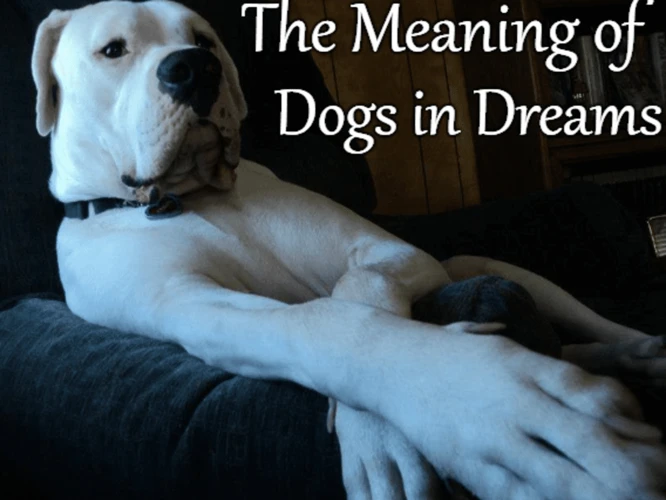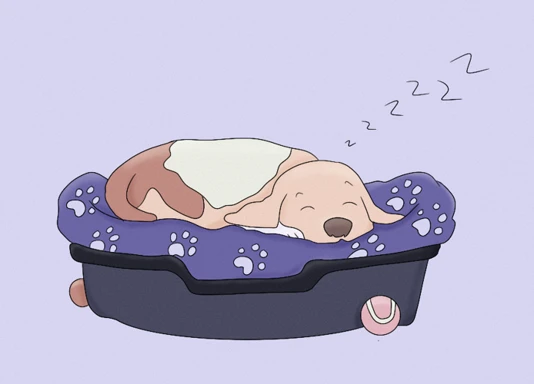Dogs have always fascinated humans with their unique abilities and behaviors. From their unwavering loyalty to their undeniable intelligence, dogs have a special place in our hearts. But have you ever wondered what goes on in their minds when they drift off to sleep? Can dogs actually dream about their owners? In this thought-provoking article, we delve into the intricate world of canine subconsciousness, exploring the fascinating science behind dog dreams. Join us on an enchanting journey as we unravel the mysteries of what happens when our furry companions close their eyes and venture into the realm of dreams.
The Science behind Dog Dreams

The enigmatic world of dog dreams has long captivated the curiosity of pet owners and scientists alike. While it’s difficult to comprehend the intricacies of a dog’s subconscious mind, research suggests that dogs do, in fact, dream. Just like humans, dogs experience a stage of sleep known as rapid eye movement (REM) sleep, which is when most dreaming occurs. During this phase, their brains exhibit similar patterns to those seen in humans, indicating that dogs may be relishing in their own imaginary worlds. Studies have shown that dogs often exhibit physical movements, such as twitches and paw movements, during REM sleep, which may be indicative of their dream activities. Though decoding the content and meaning of their dreams remains a mystery, it is intriguing to contemplate what adventures our furry friends embark upon when they close their eyes to the waking world.
1. The Nature of Dog Dreams
When exploring the nature of dog dreams, we find a fascinating blend of instinctual behaviors and daily experiences. Dogs often dream about activities that are familiar to them, such as chasing a ball, playing with their favorite toys, or even interacting with their owners. These dreams may reflect their desires, memories, and experiences from their waking lives. It’s important to note that dogs may also encounter stimuli during their dreams, leading to different reactions in their sleep. For example, if a dog dreams about encountering a pigeon, their instincts might kick in, causing them to bark or wag their tail in their sleep. While we can’t fully comprehend the intricate details of their dreams, observing their behaviors during REM sleep offers tantalizing glimpses into the immersive world of a dog’s imagination.
2. Similarities with Human Dreams
When it comes to dreaming, dogs and humans may be more alike than we realize. Studies have revealed striking similarities between dog dreams and human dreams. Just like us, dogs experience REM sleep, which is associated with vivid dreaming. The brain activity observed during this stage is remarkably similar in both species. Dogs also exhibit similar physical responses during dreams, such as twitching, whimpering, and even running in their sleep. Interestingly, dogs seem to process memories and emotions during dreaming, similar to humans. This suggests that dogs may be experiencing their own version of dream scenarios, perhaps chasing a squirrel or playing fetch with their favorite ball. While we can’t fully decipher the content and meaning of their dreams, it’s enchanting to consider the possibility that dogs, like us, enter into a realm of subconscious exploration during their slumber.
3. The Role of the Owner in Dog Dreams
The owner plays a significant role in a dog’s dreams, as they are often at the center of their world. Dogs form deep emotional bonds with their owners, and these connections can manifest in their dreams. Just as humans may dream about their loved ones, dogs may dream about their owners, depicting moments of joy, affection, or even separation anxiety. The owner’s presence and interactions throughout the day can greatly influence the content of a dog’s dreams. Positive experiences, such as playtime, belly rubs, and shared adventures, may translate into delightful dream sequences. Conversely, if a dog feels distressed or anxious, it may be reflected in their dreams as well. Understanding the impact the owner has on their dog’s dreams can further strengthen the bond between them, creating a harmonious and fulfilling relationship.
Interpreting Dog Dreams

When it comes to interpreting dog dreams, it’s essential to understand that symbolism plays a significant role. While we can’t directly ask our canine companions about the meaning behind their dream experiences, we can look for common themes and behaviors that may provide us with insights. For example, if a dog frequently dreams about chasing something, it could symbolize a desire for adventure or the need to release pent-up energy. Similarly, aggressive behavior in dreams may reflect feelings of frustration or perceived threats. By observing patterns and noting how these dreams coincide with their real-life experiences, we can begin to unravel the messages that dogs may be trying to convey. So while we may not have all the answers, the thrill of deciphering the enigmatic imagery of our dog’s dreams makes for an engaging exploration into their subconscious minds.
1. Understanding Symbolism in Dog Dreams
Understanding the symbolism in dog dreams can provide valuable insights into their subconscious thoughts and emotions. While we may never fully comprehend the exact meanings behind their dreams, paying attention to recurring symbols or themes can offer clues about their inner world. For instance, if a dog frequently dreams about chasing a pigeon, it may symbolize their desire for freedom or the pursuit of a goal. Similarly, dreaming about a black cat could represent mystery or intuition. It’s important to remember that interpretations can vary from one dog to another, and context plays a crucial role in deciphering these symbols. Observing their behavior and reactions during and after dreams can help us understand how these symbols resonate with their waking reality. So, the next time your canine companion twitches in their sleep or lets out a gentle bark, perhaps they are unraveling a mysterious dream that holds significance in their own unique way. Read more about dream symbolism here.
2. Common Themes in Dog Dreams
When it comes to the common themes in dog dreams, there are a few recurrent patterns that have been observed. One prevalent theme is the reenactment of daily activities. Dogs may dream about playing fetch in the park, going for walks with their owners, or even enjoying a tasty treat. Another frequent theme is the presence of other animals, such as squirrels, birds, or even household pets. Dogs may chase after these creatures or engage in playful interactions. It’s important to note that these dreams are not always literal representations, but rather symbolic expressions of their desires and experiences. For example, a dog dreaming about a black cat may not necessarily be a premonition of bad luck, but rather a manifestation of curiosity or fascination with the feline world. Similarly, dreams about encountering a snake trying to bite them may symbolize a perceived threat or an instinctual fear response. Understanding these common themes can provide insight into the underlying emotions and experiences that inhabit a dog’s dream world.
3. Unraveling the Messages from Dogs to their Owners
Interpreting the messages that dogs convey to their owners through dreams can be a captivating endeavor. While we may never fully understand the complexities of their dream experiences, paying attention to their behavior and emotions can provide insight into what they may be trying to communicate. For example, if a dog consistently dreams about chasing a ball, it may be indicative of a desire for playtime and engagement. Similarly, if a dog appears anxious or fearful in their dreams, it could be a reflection of underlying stress or past traumas. By observing and deciphering these subtle cues, we can deepen our understanding of our canine companions and provide them with the love and support they need. Remember, decoding the messages in dog dreams requires sensitivity and a deep connection with our furry friends, allowing us to strengthen our bond and create a harmonious relationship based on trust and understanding.
Enhancing the Dream Experience between Dogs and their Owners

Enhancing the dream experience between dogs and their owners involves creating an environment that promotes relaxation and happiness for our four-legged companions. One way to achieve this is by ensuring a soothing sleep environment for dogs, providing them with a comfortable bed and a quiet, peaceful space. Consistency in daily routines and boundaries also helps dogs feel secure, as they thrive on stability and structure. Strengthening the bond through communication and positive reinforcement is crucial, as dogs are highly social animals who seek connection with their owners. Engaging in activities that promote relaxation and happiness, such as regular walks, playtime, and mental stimulation, can contribute to a more fulfilling dream experience for both dogs and owners. By investing time and effort into understanding our dogs’ needs and nurturing their overall well-being, we can forge a deeper connection that extends beyond waking hours, enriching the dream world they inhabit.
1. Creating a Soothing Environment for Dogs
To enhance the dream experience between dogs and their owners, creating a soothing environment is crucial. Dogs, like humans, thrive in calming surroundings that promote relaxation. Here are some key tips to achieve this:
1. Provide a cozy sleeping area: Designate a comfortable space specifically for your dog’s sleep. Invest in a cozy bed or blanket that offers a sense of security and warmth.
2. Minimize noise and distractions: Reduce external noises that may disrupt your dog’s sleep. Keep the environment peaceful and free from loud sounds or sudden movements.
3. Use calming scents: Certain scents, such as lavender or chamomile, are known to have a soothing effect on dogs. Consider using aroma diffusers or sprays to create a calming atmosphere.
4. Establish a bedtime routine: Consistency is key when it comes to creating a soothing environment for your dog. Establish a predictable bedtime routine that includes activities like gentle brushing or a short walk before sleep.
By providing a tranquil setting for your furry companion, you can help them relax and enter a deeper state of sleep, enhancing the potential for vivid and enjoyable dreams. Soothing surroundings can contribute to a more fulfilling dream experience for both dogs and their owners.
2. Consistency in Daily Routine and Boundaries
Consistency in daily routine and boundaries is crucial for fostering a harmonious environment where dogs can feel secure and at ease. Dogs thrive on structure, so establishing a consistent daily schedule can help reduce their anxiety and promote a sense of stability. This includes regular feeding times, exercise routines, and designated sleep areas. By providing clear boundaries and consistently enforcing them, dogs can develop a sense of security and better understand what is expected of them. This helps create a balanced and stress-free environment for both the dog and their owner. Additionally, maintaining a consistent routine can also positively influence a dog’s sleep patterns, ensuring they have ample restful sleep to support their overall well-being. So, make sure to establish a daily routine and set clear boundaries to create a calm and nurturing space for your canine companion to relax and dream about sunny walks in the park or maybe even chasing after their favorite toys.
3. Strengthening the Bond through Communication and Positive Reinforcement
To enhance the dream experience between dogs and their owners, communication and positive reinforcement play a crucial role. Dogs are highly attuned to human emotions and respond well to clear and consistent communication. Using positive reinforcement techniques such as rewards and praise helps strengthen the bond between dogs and their owners. By rewarding desired behaviors and providing consistent feedback, dogs feel a sense of connection and understanding with their owners. This can be further reinforced through regular training sessions, where owners can establish boundaries and teach commands. Additionally, spending quality time together engaging in activities that promote relaxation and happiness can deepen the bond. Playing games, going for walks, or simply cuddling on the couch create positive associations and build trust. By prioritizing open communication and reinforcing positive behaviors, the dream experience between dogs and their owners becomes even more meaningful.
4. Engaging in Activities that Promote Relaxation and Happiness
Engaging in activities that promote relaxation and happiness can greatly enhance the dream experience between dogs and their owners. Dogs thrive on positive energy and a calming environment, so incorporating activities that help them unwind can lead to more peaceful dreams. Taking long, leisurely walks in nature allows dogs to experience new smells and sights, stimulating their senses and promoting relaxation. Additionally, practicing gentle massage techniques or providing them with cozy blankets and beds can create a serene atmosphere conducive to peaceful dreams. Playing soothing music or using aromatherapy with scents like lavender can also help dogs find tranquility in their sleep. By prioritizing their well-being and finding ways to promote relaxation and happiness, pet owners can contribute to their beloved companion’s dream-filled journey.
Real-Life Stories of Dogs Dreaming about their Owners
Real-life stories of dogs dreaming about their owners offer a glimpse into the profound connection between humans and their beloved pets. One heartwarming account involves Bailey, a golden retriever, who often exhibited joyful movements and soft barks during his sleep. His owner, Sarah, noticed that these occurrences were more frequent when she had a particularly stressful day at work or when she was away on a trip. It seemed as though Bailey was bringing comfort and solace to her through his dreams. Another remarkable story revolves around Max, a border collie, who would wag his tail vigorously in his sleep whenever his owner, Mike, called out his name in a gentle tone. These anecdotes serve as heartening reminders that dogs not only dream but may also dream specifically about their owners, showcasing the deep emotional bond they share. It’s truly a testament to the extraordinary nature of the human-dog relationship.
Conclusion
In conclusion, the world of dog dreams is a captivating and enigmatic realm. While we may never fully understand the intricacies of what occurs in a dog’s subconscious, research suggests that dogs do indeed dream. Their experiences during rapid eye movement (REM) sleep mirror those of humans, indicating that they too indulge in their own fantastical adventures. Although we may never know the true content or meaning of their dreams, it’s a fascinating concept to ponder. So, the next time you catch your canine companion in the midst of a dream, take a moment to appreciate the mysteries unfolding in their slumber. Perhaps they are chasing squirrels, playing fetch, or even dreaming about their beloved owners. The secrets of their dreams may forever remain a mystery, but one thing is for certain – dogs continue to amaze and captivate us in ways that only strengthen the extraordinary bond we share.
Frequently Asked Questions
1. Do dogs dream like humans?
Yes, dogs do dream like humans. They experience a stage of sleep called rapid eye movement (REM) sleep, during which most dreaming occurs.
2. What do dogs dream about?
The content of a dog’s dream is still a mystery, but it is believed that they may dream about their daily activities, past experiences, and interactions with their owners and other animals.
3. Do all dogs dream?
Yes, all dogs have the ability to dream. It is a natural part of their sleep cycle.
4. Can dogs have nightmares?
It is possible for dogs to have nightmares, just like humans. They may display signs of fear, anxiety, or agitation during their dreams.
5. Can dogs remember their dreams?
While dogs may not have conscious recall of their dreams, they may have a sense of emotions or memories associated with the content of their dreams.
6. How can I tell if my dog is dreaming?
You can tell if your dog is dreaming by observing their behavior during sleep. Look for twitching, paddling their legs, and movements of their eyes behind closed eyelids.
7. Can dogs dream about their owners?
There is a possibility that dogs can dream about their owners. Since dogs have a strong bond with their owners, it is likely that they might envision or recall their interactions and experiences with them in their dreams.
8. Do different dog breeds dream differently?
While there is no concrete evidence suggesting that different dog breeds dream differently, it is believed that breed characteristics and individual experiences may influence the content and nature of their dreams.
9. Should I wake up my dog if they are having a bad dream?
It is best not to wake up your dog if they are having a bad dream. Allow them to naturally wake up from the dream and provide reassurance and comfort afterwards, if needed.
10. Can dogs daydream?
While dogs may engage in periods of deep thought or appear lost in their own world, it is unclear whether this can be classified as “daydreaming” in the same way that humans experience it.







